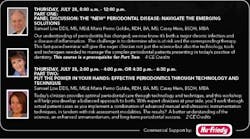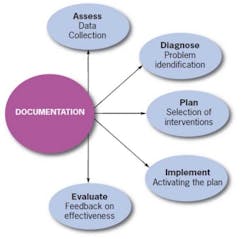The "new" periodontal disease: navigate the emerging solutions (Part 1)
Aug. 4, 2011
By Maria Perno Goldie, RDH, MS
As mentioned in the introduction, I shared this presentation with Samuel Low, DDS, MS, MEd, and Casey Hein, BSDH, MBA. In the morning session, we presented how our understanding of periodontitis has changed, that we now know that it is a major chronic infection and a disease of inflammation. The challenge is to determine who is at risk and the corresponding therapy. This seminar gave clinicians the science and also the technology, tools and techniques needed to manage the complex periodontal patients presenting in today’s practice of dental hygiene and dentistry. In Part Two, we had two hands-on sessions entitled: “Put the Power in Your Hands: Effective Periodontics through Technology and Technique.” The workshops helped to develop a balanced approach to optimal periodontal care through technology and technique. We worked through actual patient cases as the students implemented a combination of advanced manual and ultrasonic instrumentation techniques, in tandem with risk assessment modalities. The results were a better understanding of the science, an enhanced armamentarium, and long-term periodontal success.
In my section during the morning session, I covered: Dental Hygiene Process of Care; Risk Assessment; Interprofessional Collaborative Practice Competencies; Uncovering Systemic Conditions that influence Periodontal Disease and Oral Health - a bidirectional relationship; and Behavioral Change Agent -- Who’s in the Chair? Former Surgeon General, Dr. C. Everett Koop, said “A person is not healthy without good oral health.” Conditions and disease associated with oral health problems are tobacco use, smoking; pharmaceuticals, such as steroids, anti-epilepsy, oral contraceptives, and cancer therapy; diet, obesity, diabetes; systemic diseases; hormonal changes; systemic disease, such as autoimmune, inflammatory, HIV, osteoporosis, neutrophil disorders, and renal. In “Oral Health in America, A Report of the Surgeon General,” it states that the mouth reflects general health and well-being, as well as playing a diagnostic role. (Oral Health in America: A Report of the Surgeon General, DHHS 2000. www.surgeongeneral.gov/library/oralhealth/). It is a portal, as well as a barrier, for infections, and saliva, buccal cells and other oral components have additional diagnostic potential. In a new study, the authors identified specific biomarker and microbial signatures that are associated with gingival inflammation, interleukin (IL)-1 polymorphism. (Lee A, Ghaname CB, Braun TM, Sugai JV, Teles RP, Loesche WJ, Kornman KS, Giannobile WV and Kinney JS. Bacterial and Salivary Biomarkers Predict the Gingival Inflammatory Profile. Journal of Periodontology. 0:0, 1-13).
The study delved into the relationship of gingivitis with salivary biomarkers, periodontal pathogens and interleukin (IL)-1 polymorphism following a transient inflammatory burden. Another study analyzed with protein arrays for 14 proinflammatory and bone turnover markers. (Kinney JS, Morelli T, Braun T, Ramseier CA, Herr AE, Sugai JV, Shelburne CE, Rayburn LA, Singh AK, and Giannobile WV. Saliva/Pathogen Biomarker Signatures and Periodontal Disease Progression. J Dent Res. June 2011 90: 752-758). The conclusion is that the use of salivary and biofilm biomarkers offers potential for the identification of periodontal disease progression or stability.In my next section, I discussed Interprofessional Collaborative Practice. Six national health professions associations and three private foundations released new reports detailing their recommendations for interprofessional education in the health professions. These reports provide the new competencies and action strategies to be implemented in educational institutions in the United States, providing the foundation for improved patient care and services. Along with the American Dental Education Association (ADEA), contributors to the first report, Core Competencies for Interprofessional Collaborative Practice, are the American Association of Colleges of Nursing, the American Association of Colleges of Osteopathic Medicine, the American Association of Colleges of Pharmacy, the Association of American Medical Colleges, and the Association of Schools of Public Health. These six associations are part of the Interprofessional Education Collaborative (IPEC), and their purpose was to identify individual-level core interprofessional competencies for future health professionals. (www.aamc.org/download/186750/data/core_competencies.pdf). As well, more than 80 leaders from the Health Resources and Services Administration; the Josiah Macy Jr. Foundation; the Robert Wood Johnson Foundation; and the ABIM Foundation, in partnership with Interprofessional Education Collaborative (IPEC), met in February 2011 to review the competencies set forth by the IPEC group and to create action strategies. (www.aacn.nche.edu/Education/pdf/IPECProceedings.pdf) From this meeting, Team-Based Competencies, Building a Shared Foundation for Education and Clinical Practice was developed. These action strategies implement the IPEC core competencies and provide a means of instilling collaboration among health professionals. Another report discusses Collaborative Practice in Dentistry, Practice and Potential. (futurehealth.ucsf.edu/Content/29/2011-01_Collaborative_Practice_in_American_Dentistry_Practice_and_Potential.pdf).
In addition, I presented the Standards for Clinical Dental Hygiene Practice. I was amazed that only about three individuals were familiar with them. The primary purpose of the Standards for Clinical Dental Hygiene Practice is to assist dental hygiene clinicians in the provider-patient relationship, to facilitate the implementation of collaborative, patient centered care in multidisciplinary teams of health professionals. This collaboration can occur in a variety of practice settings including community and public health centers, hospitals, school based programs, long term care facilities, outreach and home care programs.
The secondary purpose of these Standards is to educate other healthcare providers, policy makers, and the public about the clinical practice of dental hygiene. (www.adha.org/downloads/adha_standards08.pdf). The Dental Hygiene Process of Care is highlighted: Assessment; Dental Hygiene Diagnosis; Planning; Implementation; Evaluation; and Documentation. I also went into some depth about Risk Assessment.While inflammation was also covered by Dr. Low and Casey, I mentioned a special supplement to the Journal of Periodontology, which has: Introduction; Inflammation and Factors that Regulate the Inflammatory Response; Inflammation and Disease; Inflammation and Periodontal Disease; Management of Disease: A Look Ahead; and Workshop Summary-Clinical Implications. It is a very informative issue. (www.joponline.org/toc/jop/79/8s) While we know that a person’s genetic makeup cannot be changed, the way certain genes are expressed in certain tissues can be affected by lifestyle choices. Genetic polymorphisms in a large number of genes have been shown to quantitatively and qualitatively affect the immune and inflammatory responses. (Jaenisch R & Bird A. Epigenetic regulation of gene expression: how the genome integrates intrinsic and environmental signals. Nature Genetics. 33, 245-254 (2003)). This has effects on susceptibility or severity of a large number of diseases with an inflammatory component. Nutritional factors can have profound effects on the expression of specific genes by epigenetic modification. These may be passed on to subsequent generations, with potentially detrimental effects. An example is folate insufficiency. Stress, depression, and salivary cortisol were correlated with measures of periodontal disease in a study. (Rosania AE, Low KG, McCormick CM, Rosania DA. Stress, depression, cortisol, and periodontal disease. J Periodontol. 2009 Feb; 80(2):260-6.) Oral care neglect during periods of stress and depression was associated with attachment loss and missing teeth. Stress and depression may be associated with periodontal destruction through behavioral and physiologic mechanisms. Addressing psychologic factors, such as depression, may be an important part of periodontal preventive maintenance. This study supported an earlier study, and the data corroborate the thesis that periodontitis patients with inadequate stress behavior strategies (defensive coping) are at greater risk for severe periodontal disease. (Wimmer G. Coping With Stress: Its Influence on Periodontal Disease. Journal of Periodontology. November 2002, Vol. 73, No. 11, Pages 1343-1351.) Further study needed with inappropriate coping styles for advancement of periodontal disease. In a systematic review, the majority of studies showed a positive relationship between stress/psychological factors and periodontal disease (Peruzzo DC, Benatti BB, Ambrosano GM, Nogueira-Filho GR, Sallum EA, Casati MZ, Nociti FH Jr. A systematic review of stress and psychological factors as possible risk factors for periodontal disease. J Periodontol. 2007 Aug; 78(8):1491-504).In Part 2 of this article, I will continue to discuss systemic conditions that may affect periodontal disease. Obesity, tobacco, changes during a women’s life cycle, and other disorders will be discussed in the next issue.
Maria Perno Goldie, RDH, MS
To read previous articles in RDH eVillage FOCUS from 2011 written by Maria Perno Goldie, go to articles.











